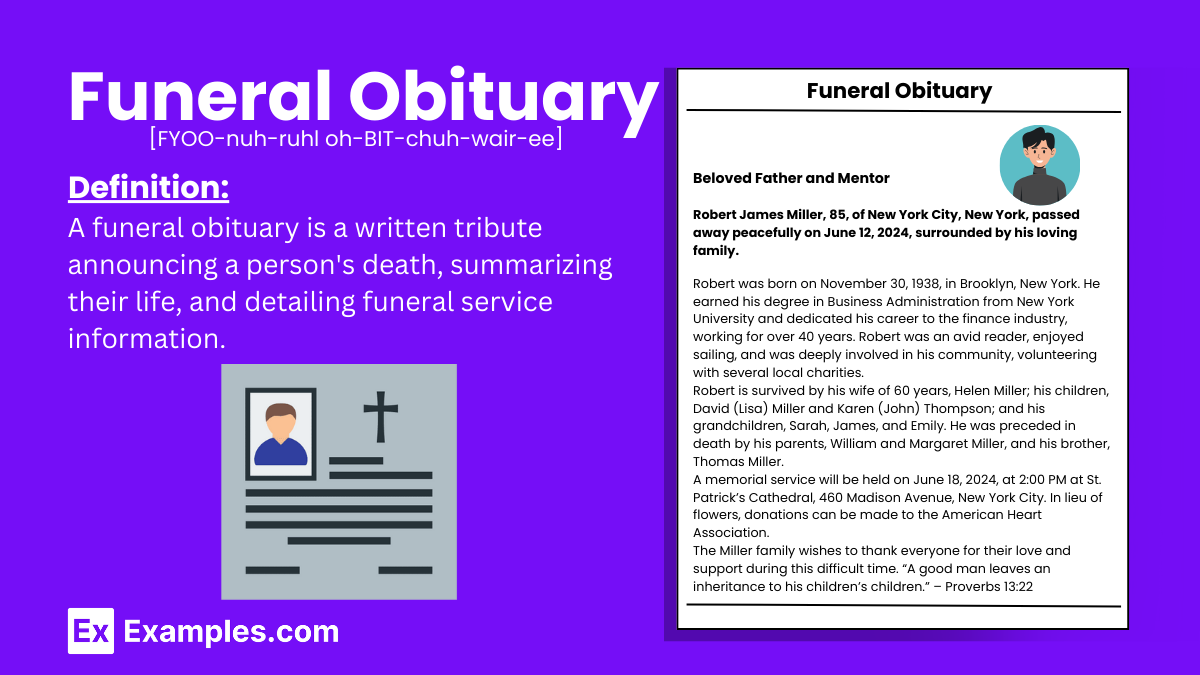15+ Funeral Obituary Examples
The loss of a loved one is a challenging time, filled with grief and a myriad of responsibilities. One such responsibility is the creation of a funeral obituary, a task that can seem daunting amidst the emotional turmoil. This article aims to provide guidance on how to prepare a funeral obituary, with examples and frequently asked questions to help you through this difficult process.
What is a Funeral Obituary?
A funeral obituary is a written notice announcing someone’s death, often including a brief biography, details of the funeral service, and information about surviving family members. It may also share the deceased’s achievements, interests, and a few heartfelt words from loved ones. Obituaries are typically published in newspapers and online platforms to inform the community and honor the deceased’s life.
Funeral Obituary Examples
1. Traditional Obituary
Jane Marie Smith, 75, of Springfield, Illinois, passed away peacefully on June 25, 2024.
Born on March 12, 1949, to Robert and Mary Johnson, Jane was a beloved wife, mother, and grandmother. She graduated from the University of Illinois with a degree in Education and dedicated over 30 years to teaching elementary school students, inspiring countless young minds.
Jane is survived by her loving husband of 50 years, John Smith; her children, Michael (Sarah) Smith and Emily (Robert) Johnson; and her grandchildren, Anna, James, and Lily. She was preceded in death by her parents and her sister, Linda Johnson.
A memorial service will be held on July 1, 2024, at 10:00 AM at First Presbyterian Church, 123 Main Street, Springfield, officiated by Reverend David Harris. A reception will follow at the church hall. In lieu of flowers, the family requests donations be made to the American Cancer Society.
The family extends their heartfelt thanks to all who have offered support during this difficult time. “Life is not measured by the number of breaths we take, but by the moments that take our breath away.”
2. Obituary for a Veteran
John Michael Anderson, 82, of Austin, Texas, passed away on July 10, 2024, surrounded by his family.
John was born on April 5, 1942, in San Antonio, Texas, to William and Margaret Anderson. He proudly served in the United States Navy for 20 years, achieving the rank of Chief Petty Officer. After retiring from the Navy, John pursued a career in engineering and worked for Lockheed Martin for 25 years.
John is survived by his wife, Patricia Anderson; his children, Laura (David) Miller and Kevin (Emily) Anderson; and his grandchildren, Sophia and Ethan. He was preceded in death by his parents and his brother, Richard Anderson.
A funeral service with full military honors will be held on July 15, 2024, at 2:00 PM at Fort Sam Houston National Cemetery, 1520 Harry Wurzbach Road, San Antonio. In lieu of flowers, donations can be made to the Wounded Warrior Project.
The family would like to express their deep gratitude for the love and support shown by friends and relatives. “The brave die never, though they sleep in dust: Their courage nerves a thousand living men.” – Minot J. Savage
3. Obituary for a Community Leader
Linda Ann Thompson, 68, of Boulder, Colorado, passed away unexpectedly on August 3, 2024.
Born on September 15, 1955, in Denver, Colorado, Linda was a vibrant member of the Boulder community. She graduated from Colorado State University with a degree in Social Work and spent her career advocating for children and families in need. Linda was a founding member of the Boulder Family Resource Center and served on the board of several local non-profits.
Linda is survived by her partner, Mark Reynolds; her daughter, Samantha (Chris) Davis; and her grandchildren, Olivia and Noah. She was predeceased by her parents, George and Eleanor Thompson.
A celebration of Linda’s life will be held on August 10, 2024, at 11:00 AM at the Boulder Community Center, 456 Elm Street, Boulder. In lieu of flowers, donations may be made to the Boulder Family Resource Center.
The family wishes to thank everyone for their outpouring of love and support during this difficult time. “To live in hearts we leave behind is not to die.” – Thomas Campbell
4. Obituary for a Young Person
Emily Grace Martin, 22, of Nashville, Tennessee, passed away on June 15, 2024.
Emily was born on February 2, 2002, in Nashville. She graduated from Vanderbilt University with a degree in Music Performance and was a gifted violinist. Emily was passionate about music and dedicated her life to sharing her talent with others, performing in numerous orchestras and teaching young students.
Emily is survived by her parents, David and Laura Martin; her brother, Jason Martin; and her grandparents, William and Susan Martin, and Charles and Betty Thompson.
A memorial concert in Emily’s honor will be held on June 22, 2024, at 7:00 PM at the Nashville Symphony Hall, 123 Symphony Place, Nashville. In lieu of flowers, the family requests donations be made to the Emily Martin Memorial Scholarship Fund at Vanderbilt University.
The Martin family expresses their heartfelt appreciation for the love and support they have received. “Music expresses that which cannot be said and on which it is impossible to be silent.” – Victor Hugo
5. Obituary for a Teacher
Sarah Louise Carter, 54, of Boston, Massachusetts, passed away on May 29, 2024, after a courageous battle with cancer.
Sarah was born on October 12, 1969, in Boston. She graduated from Boston University with a degree in Education and dedicated her life to teaching. Sarah spent 30 years as an English teacher at Eastwood High School, where she was beloved by students and colleagues alike for her passion and dedication.
Sarah is survived by her husband, Paul Carter; her son, Matthew Carter; her parents, James and Ellen Roberts; and her sister, Anna (Michael) Stevens.
A funeral service will be held on June 3, 2024, at 11:00 AM at St. Mary’s Church, 456 Oak Street, Boston. In lieu of flowers, the family requests donations be made to the American Cancer Society in Sarah’s name.
The family extends their heartfelt thanks to the medical staff at Boston General Hospital for their care and compassion. “A teacher affects eternity; they can never tell where their influence stops.” – Henry Adams
Funeral Obituary Examples for Mother
1. Loving Mother and Grandmother
Mary Elizabeth Johnson, 78, of Denver, Colorado, passed away peacefully on June 15, 2024, surrounded by her family.
Mary was born on April 10, 1946, in Denver to Robert and Margaret Anderson. She graduated from the University of Colorado with a degree in Nursing and dedicated her life to caring for others, both as a nurse and as a devoted mother and grandmother. Mary was an active member of her church and loved gardening, reading, and spending time with her family.
Mary is survived by her children, David (Laura) Johnson and Emily (Mark) Davis; her grandchildren, Sarah, Michael, and Emma; and her sister, Linda Thompson. She was preceded in death by her husband, John Johnson, and her parents.
A memorial service will be held on June 22, 2024, at 11:00 AM at St. John’s Episcopal Church, 123 Main Street, Denver. In lieu of flowers, donations can be made to the Denver Hospice.
The family extends their heartfelt thanks to all who have offered support during this difficult time. “Her life was a blessing, her memory a treasure, she is loved beyond words and missed beyond measure.”
2. Devoted Mother and Community Volunteer
Linda Marie Thompson, 65, of Springfield, Illinois, passed away on July 8, 2024.
Linda was born on October 2, 1958, in Springfield. She graduated from Illinois State University with a degree in Social Work. Linda dedicated her life to helping others, both through her career as a social worker and her extensive volunteer work in the community. She was an avid baker, known for her famous chocolate chip cookies, and a passionate advocate for children’s education.
Linda is survived by her children, John (Susan) Thompson and Karen (James) Harris; her grandchildren, Tyler and Olivia; and her brothers, Robert (Jane) Johnson and Michael (Lisa) Johnson. She was preceded in death by her parents, George and Martha Johnson.
A celebration of Linda’s life will be held on July 15, 2024, at 10:00 AM at the First United Methodist Church, 456 Elm Street, Springfield. In lieu of flowers, the family requests donations be made to the Springfield Children’s Education Fund.
The family would like to thank everyone for their kind words and support. “To the world you may be one person; but to one person you may be the world.”
3. Cherished Mother and Teacher
Susan Ann Parker, 72, of Austin, Texas, passed away on May 20, 2024.
Susan was born on March 18, 1952, in Austin. She earned her degree in Education from the University of Texas and spent over 40 years teaching elementary school. Susan touched the lives of countless children with her kindness, patience, and dedication. She enjoyed quilting, reading, and spending time with her family.
Susan is survived by her children, Lisa (Tom) Brown and Steven Parker; her grandchildren, Megan and Ryan; and her sisters, Carol (Jim) Walker and Nancy (Paul) Green. She was preceded in death by her husband, Richard Parker, and her parents.
A memorial service will be held on May 27, 2024, at 2:00 PM at Grace Lutheran Church, 789 Oak Street, Austin. In lieu of flowers, donations may be made to the Austin Public Library Foundation.
The Parker family appreciates the love and support from friends and family during this time. “A life well-lived leaves a legacy of love.”
4. Beloved Mother and Nurse
Patricia Louise Harris, 64, of Boston, Massachusetts, passed away on April 10, 2024.
Patricia was born on January 5, 1960, in Boston. She graduated from Boston College with a degree in Nursing and worked as a dedicated nurse for over 35 years. Patricia was a loving mother who enjoyed cooking, gardening, and volunteering at her local animal shelter.
Patricia is survived by her children, Daniel (Emily) Harris and Jennifer (Brian) Clark; her grandchildren, Ava and Ethan; and her brother, James (Laura) Mitchell. She was preceded in death by her husband, Robert Harris, and her parents.
A funeral service will be held on April 17, 2024, at 1:00 PM at St. Mary’s Church, 234 Pine Street, Boston. In lieu of flowers, the family requests donations be made to the Boston Animal Rescue League.
The family extends their heartfelt gratitude to all who have provided support. “Those we love don’t go away; they walk beside us every day.”
5. Dedicated Mother and Artist
Margaret Helen Carter, 70, of San Francisco, California, passed away on March 30, 2024.
Margaret was born on June 22, 1953, in San Francisco. She graduated from San Francisco State University with a degree in Fine Arts and was a talented painter. Margaret’s artwork was displayed in numerous galleries, and she was known for her vibrant, colorful pieces. She loved traveling, painting, and spending time with her family.
Margaret is survived by her children, Amanda (Chris) Lewis and Andrew (Melissa) Carter; her grandchildren, Jack and Emma; and her brother, William (Kathy) Adams. She was preceded in death by her husband, Thomas Carter, and her parents.
A memorial service will be held on April 6, 2024, at 3:00 PM at the San Francisco Art Gallery, 567 Market Street, San Francisco. In lieu of flowers, donations can be made to the San Francisco Art Institute.
The Carter family would like to thank everyone for their love and support during this difficult time. “Art is not what you see, but what you make others see.” – Edgar Degas
Funeral Obituary Examples for Father
1. Beloved Father and Husband
Robert James Miller, 85, of New York City, New York, passed away peacefully on June 12, 2024, surrounded by his loving family.
Robert was born on November 30, 1938, in Brooklyn, New York. He earned his degree in Business Administration from New York University and dedicated his career to the finance industry, where he worked for over 40 years. Robert was an avid reader, enjoyed sailing, and was deeply involved in his community, volunteering with several local charities.
Robert is survived by his wife of 60 years, Helen Miller; his children, David (Lisa) Miller and Karen (John) Thompson; and his grandchildren, Sarah, James, and Emily. He was preceded in death by his parents, William and Margaret Miller, and his brother, Thomas Miller.
A memorial service will be held on June 18, 2024, at 2:00 PM at St. Patrick’s Cathedral, 460 Madison Avenue, New York City. In lieu of flowers, donations can be made to the American Heart Association.
The Miller family wishes to thank everyone for their love and support during this difficult time. “A good man leaves an inheritance to his children’s children.” – Proverbs 13:22
2. Devoted Father and Veteran
John Henry Wilson, 78, of Los Angeles, California, passed away on July 4, 2024.
John was born on September 5, 1945, in Los Angeles. He proudly served in the United States Army for 20 years, achieving the rank of Sergeant Major. After his military service, John pursued a career in law enforcement, working as a police officer for the LAPD for 25 years. He enjoyed fishing, woodworking, and spending time with his family.
John is survived by his children, Michael (Jessica) Wilson and Rebecca (Andrew) Carter; his grandchildren, Daniel and Olivia; and his sister, Susan (George) Harris. He was preceded in death by his wife, Margaret Wilson, and his parents.
A funeral service with full military honors will be held on July 10, 2024, at 11:00 AM at the Los Angeles National Cemetery, 950 South Sepulveda Boulevard, Los Angeles. In lieu of flowers, donations can be made to the Wounded Warrior Project.
The Wilson family extends their heartfelt thanks for the outpouring of love and support. “Greater love has no one than this: to lay down one’s life for one’s friends.” – John 15:13
3. Cherished Father and Educator
Michael Anthony Davis, 72, of Chicago, Illinois, passed away on May 14, 2024.
Michael was born on October 22, 1951, in Chicago. He graduated from Northwestern University with a degree in English Literature and spent over 35 years teaching high school English, inspiring countless students with his passion for literature and learning. Michael loved writing, playing the piano, and spending weekends at the family cabin in Wisconsin.
Michael is survived by his children, Laura (Mark) Jensen and Brian (Megan) Davis; his grandchildren, Natalie and Lucas; and his brother, Richard (Patricia) Davis. He was preceded in death by his wife, Diane Davis, and his parents.
A celebration of Michael’s life will be held on May 21, 2024, at 10:00 AM at Grace Lutheran Church, 123 Elm Street, Chicago. In lieu of flowers, the family requests donations be made to the Chicago Public Library Foundation.
The Davis family would like to express their sincere gratitude for the support and prayers during this time. “Education is the most powerful weapon which you can use to change the world.” – Nelson Mandela
4. Loving Father and Community Leader
William Charles Thompson, 80, of Seattle, Washington, passed away on April 25, 2024.
William was born on February 17, 1944, in Seattle. He earned his degree in Political Science from the University of Washington and dedicated his career to public service, serving as a city council member for over 30 years. William was passionate about local politics, environmental conservation, and community building.
William is survived by his children, Jennifer (Paul) Martin and Steven (Anna) Thompson; his grandchildren, Samantha, Nicholas, and Grace; and his sister, Mary (Robert) Collins. He was preceded in death by his wife, Elizabeth Thompson, and his parents.
A memorial service will be held on May 2, 2024, at 1:00 PM at the First Presbyterian Church, 789 Pine Street, Seattle. In lieu of flowers, donations can be made to the Sierra Club.
The Thompson family is deeply grateful for the kindness and support shown by friends and the community. “The best way to find yourself is to lose yourself in the service of others.” – Mahatma Gandhi
5. Dedicated Father and Entrepreneur
Richard Lee Johnson, 67, of Miami, Florida, passed away on March 10, 2024.
Richard was born on August 15, 1956, in Miami. He graduated from the University of Miami with a degree in Business Management and went on to found several successful businesses in the Miami area. Richard was known for his entrepreneurial spirit, his love for boating, and his commitment to his family.
Richard is survived by his children, Amanda (Chris) Lewis and Andrew (Melissa) Johnson; his grandchildren, Jack and Emma; and his sister, Carol (James) Robinson. He was preceded in death by his wife, Linda Johnson, and his parents.
A memorial service will be held on March 17, 2024, at 3:00 PM at the Miami Yacht Club, 1001 MacArthur Causeway, Miami. In lieu of flowers, donations can be made to the Miami Children’s Hospital Foundation.
The Johnson family extends their heartfelt thanks for the support and love received during this time. “The measure of a man’s life is the well-spending of it, and not the length.” – Plutarch
More Examples & Samples of Funeral Obituary in PDF
1. Writing Funeral Obituary Example
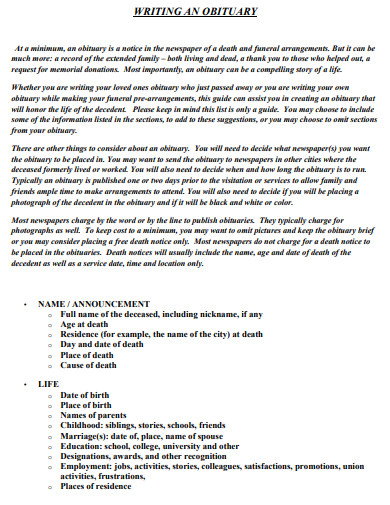
snodgrassfuneral.com
2. Sample Funeral Obituary Example

augustafuneralnotices.com
3. Funeral Obituary Template

s3.amazonaws.com
4. Child Funeral Obituary Example
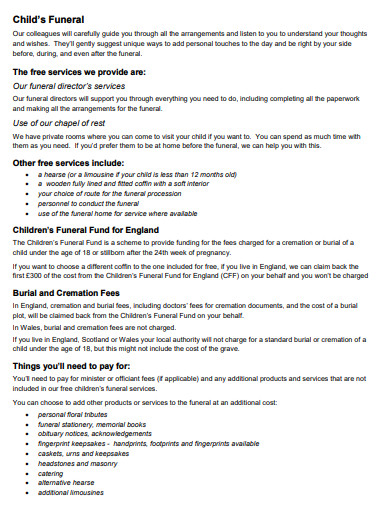
gbarlowandsons.co.uk
5. Short Funeral Obituary Example
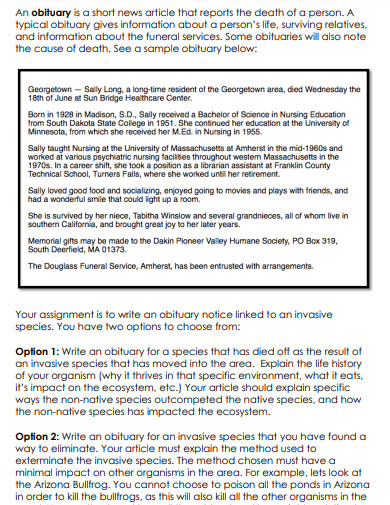
gsiccharter.com
6. Blank Funeral Obituary Example
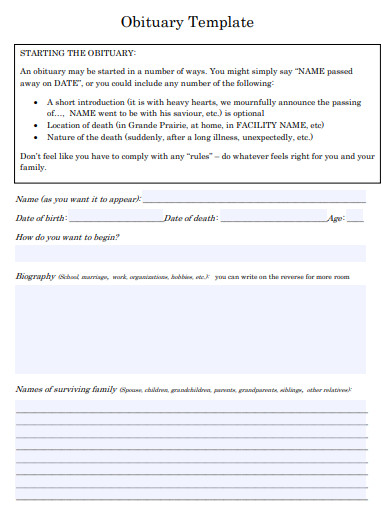
bearcreekfuneral.com
7. Written Funeral Obituary Example
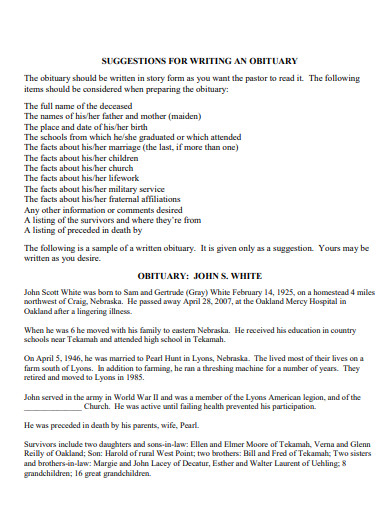
pelanfuneralservices.com
8. Simple Funeral Obituary Example
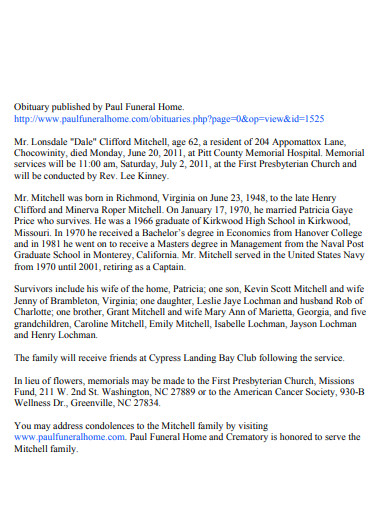
usnscf.com
Key Elements of a Funeral Obituary
A funeral obituary serves as a heartfelt tribute to the deceased, honoring their life and legacy. It is a vital piece of communication for the bereaved family, friends, and the community. Below are the key elements that should be included in a funeral obituary to ensure it is comprehensive, respectful, and informative.
1. Announcement of Death
Begin with a simple and clear announcement of the death. This typically includes:
- Full Name: Include any commonly known nicknames.
- Date of Death: Mention the day, month, and year.
- Age: The age at the time of death.
Example: “Jane Marie Smith, aged 75, passed away peacefully on June 25, 2024.”
2. Biographical Information
Provide a brief overview of the deceased’s life. This can include:
- Date and Place of Birth: When and where they were born.
- Parents’ Names: Especially if the parents are well-known or important in the community.
- Education: Schools and degrees obtained.
- Career: Major jobs and accomplishments in their professional life.
- Military Service: If applicable, including branch and rank.
- Hobbies and Interests: Personal interests, hobbies, and community involvement.
3. Family Information
List the immediate family members. This includes:
- Predeceased Family: Spouse, children, or parents who have already passed away.
- Surviving Family: Spouse, children, grandchildren, siblings, and other close relatives.
Example: “Jane is survived by her loving husband, John Smith; two children, Michael (and wife Sarah) Smith and Emily (and husband Robert) Johnson; and three grandchildren.”
4. Service Information
Provide details about the funeral or memorial services, such as:
- Date and Time: When the service will be held.
- Location: Name and address of the venue.
- Officiant: Name of the person conducting the service.
- Reception Details: If there is a reception following the service, include these details as well.
5. Special Requests or Instructions
Include any specific requests from the family, such as:
- Donations: Charities or causes to which donations can be made in memory of the deceased.
- Flowers: Information on whether flowers are welcome or if donations are preferred instead.
Example: “In lieu of flowers, the family requests donations be made to the American Cancer Society.”
6. Closing Statement
End with a closing statement that reflects the sentiments of the family. This can be a message of thanks, a prayer, or a meaningful quote.
Example: “The family extends their heartfelt thanks to all who have offered support during this difficult time.”
7. Photo
Including a recent photo of the deceased can add a personal touch and help readers remember them fondly.
How to Publish a Funeral Obituary
Publishing a funeral obituary is a thoughtful way to inform the community of a loved one’s passing and share their life story. Here’s a step-by-step guide to help you publish a meaningful obituary.
1. Write the Obituary
- Gather Information: Include personal details, life summary, family information, service details, and special requests.
- Draft the Obituary: Write a draft with key elements: announcement of death, biographical info, family info, service info, special requests, closing statement, and photo (optional).
2. Choose the Publication Method
- Local Newspapers: Contact local newspapers for submission guidelines, costs, and deadlines.
- Online Obituary Websites: Use sites like Legacy.com for extensive content and multimedia elements.
- Social Media: Share on platforms like Facebook with adjusted privacy settings.
3. Submit the Obituary
- Newspaper Submission: Follow submission guidelines, provide payment if needed, and request confirmation.
- Online Submission: Create an account, upload content, preview, and publish.
- Social Media Posting: Compose and share the post with relevant hashtags and groups.
4. Notify Family and Friends
- Email: Send the obituary link to family and friends.
- Printed Copies: Provide printed copies for those without internet access.
- Funeral Programs: Include the obituary in the service program.
5. Follow Up
- Thank You Notes: Send thank you notes to contributors.
- Monitor Online Entries: Respond to messages and condolences in online guestbooks.
Tips for Writing a Meaningful Obituary
Writing an obituary is a powerful way to honor and celebrate the life of a loved one. Here are some essential tips to help you craft a meaningful and heartfelt obituary:
1. Start with the Basics
- Full Name and Age: Clearly state the full name and age at the time of passing.
- Date and Place of Death: Include the date and location of death.
2. Share Biographical Details
- Birth Information: Mention the date and place of birth.
- Family Information: List surviving family members and those who have predeceased the deceased.
- Education and Career: Highlight significant educational achievements and career milestones.
3. Include Personal Stories and Traits
- Hobbies and Interests: Describe their passions, hobbies, and interests.
- Personality Traits: Share anecdotes that illustrate their character and personality.
- Memorable Moments: Include special memories or stories that capture their essence.
4. Detail Service Information
- Date, Time, and Location: Provide the specifics of the funeral or memorial service.
- Officiant: Mention the name of the person leading the service.
- Reception Details: Include any post-service gathering details.
5. Add Special Requests
- Donations: Specify any charities or causes in lieu of flowers.
- Memorial Contributions: Include instructions for contributions or memorial funds.
6. Craft a Thoughtful Closing
- Thank You Note: Express gratitude to those who have supported the family.
- Closing Statement: End with a meaningful quote, poem, or sentiment that reflects the deceased’s life and values.
7. Review and Edit
- Proofread: Check for spelling, grammar, and factual accuracy.
- Seek Feedback: Ask family members or close friends to review the obituary.
8. Include a Photo
- Select a Photo: Choose a recent or cherished photo that represents the deceased well.
- Format Appropriately: Ensure the photo is of high quality and fits the publication’s guidelines.
How to Write a Funeral Obituary
Writing a funeral obituary is a way to celebrate the life of a loved one and inform the community of their passing. Here’s a step-by-step guide to help you create a meaningful and respectful obituary.
1. Gather Essential Information
- Full Name and Age: Include the full name, including any nicknames, and age at the time of death.
- Date and Place of Death: Provide the exact date and location of death.
- Date and Place of Birth: Mention when and where the deceased was born.
2. Outline Biographical Details
- Education: List significant educational achievements and institutions attended.
- Career: Highlight major career milestones and accomplishments.
- Military Service: If applicable, include details of military service.
- Hobbies and Interests: Mention passions, hobbies, and community involvement.
3. Include Family Information
- Predeceased Family Members: Note any immediate family members who passed away before the deceased.
- Surviving Family Members: List the names of close surviving family members, including spouses, children, grandchildren, and siblings.
4. Provide Service Information
- Funeral or Memorial Service: Include the date, time, and location of the service.
- Officiant: Mention the name of the person conducting the service.
- Reception Details: Provide information about any reception following the service.
5. Add Special Requests or Instructions
- Donations: Specify any preferred charities or causes for donations in lieu of flowers.
- Flower Requests: State if flowers are accepted or if the family prefers donations.
6. Craft a Closing Statement
- Message of Thanks: Thank those who have offered support and condolences.
- Meaningful Quote or Poem: End with a quote, poem, or sentiment that reflects the deceased’s life and values.
7. Review and Edit
- Proofread: Check for spelling, grammar, and factual accuracy.
- Seek Feedback: Have family members or close friends review the obituary for additional insights and corrections.
8. Include a Photo (Optional)
- Select a Photo: Choose a recent or favorite photo of the deceased.
- Ensure Quality: Make sure the photo is clear and appropriately sized for publication.
How long should an obituary be?
An obituary typically ranges from 200 to 450 words, providing a concise yet comprehensive summary of the deceased’s life, family, and service details.
What information should be included in an obituary?
Include the deceased’s full name, age, date of birth and death, biographical details, family members, service information, and any special requests or donations.
How can I publish an obituary?
You can publish an obituary in local newspapers, online obituary websites, or social media platforms. Contact the chosen medium for submission guidelines and costs.
Can I include a photo in an obituary?
Yes, including a recent or cherished photo of the deceased adds a personal touch and helps readers remember them fondly. Ensure the photo is high quality.
Should I mention predeceased family members in an obituary?
Yes, it is customary to mention immediate family members who have predeceased the deceased, acknowledging their memory and connection to the deceased.
How do I announce a private funeral service in an obituary?
You can state that a private service will be held and provide details for a memorial service or reception if applicable, without disclosing the private event’s specifics.
How can I make an obituary more personal?
Share anecdotes, hobbies, achievements, and personality traits that capture the essence of the deceased. Including meaningful quotes or sentiments can also add a personal touch.
Is it appropriate to request donations instead of flowers?
Yes, many families request donations to a charity or cause meaningful to the deceased in lieu of flowers. Include donation details in the obituary.
Can I include special acknowledgments in an obituary?
Yes, you can thank medical staff, caregivers, or anyone who provided significant support. Express gratitude to those who have supported the family during this time.
How do I handle sensitive family information in an obituary?
Be respectful and considerate. You can acknowledge family dynamics without revealing personal details. Focus on honoring the deceased and their relationships.



